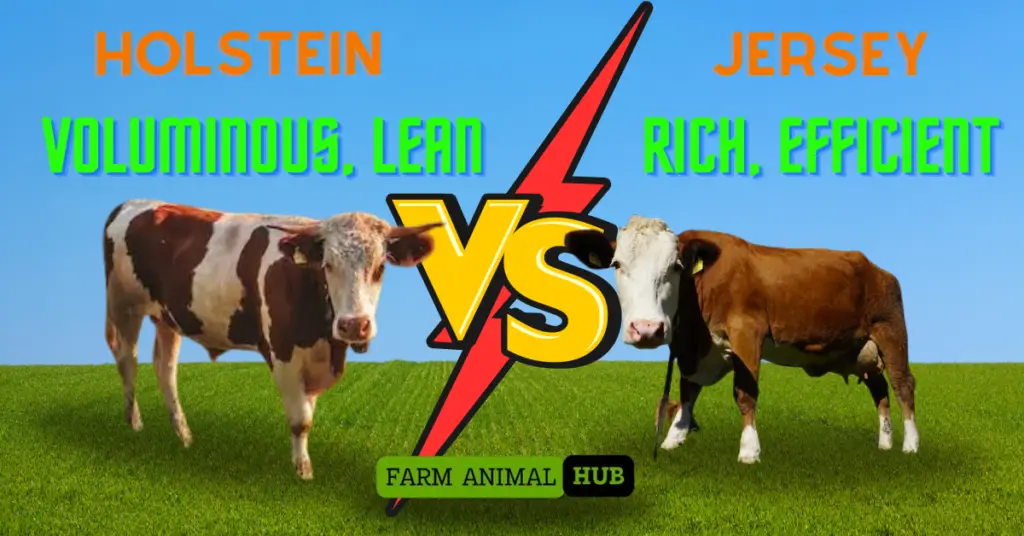
Holstein vs Jersey! Dairy farming isn’t a one-size-fits-all operation. Choosing the right cow breed is a pivotal decision, impacting everything from milk production to your bottom line. Two breeds often take center stage in this debate: the Holstein Friesian and the Jersey. Known for their distinct characteristics, these bovine beauties offer unique advantages depending on your farming goals. Let’s dive into the milk (and moo) of the matter!
Holstein vs Jersey Milk: A Deep Dive into Composition and Uses
Think of milk as more than just a refreshing drink – it’s a diverse ingredient with a complex composition. Holsteins and Jerseys produce milk with notable differences:
- Fat Content: Jerseys are the undisputed champs here, boasting significantly higher butterfat content. This makes their milk ideal for rich products like cheese, butter, and ice cream. Holsteins, while producing more milk overall, have a lower butterfat percentage.
- Protein Content: Holsteins edge out Jerseys in protein content, making their milk excellent for drinking or producing protein-rich dairy products like yogurt.
- Lactose Content: Both breeds have similar lactose levels, the sugar that gives milk its sweetness.
- Overall Nutritional Differences: While both offer essential nutrients, Jersey milk packs a bigger punch in terms of fat-soluble vitamins and overall energy density.
Holstein vs Jersey Cows: Physical Traits & Temperament
Beyond milk, these breeds have distinct physical and behavioral characteristics:
- Size: Holsteins are the gentle giants of the dairy world, significantly larger than the compact Jerseys.
- Color: Holsteins are iconic for their black and white markings, while Jerseys sport a beautiful fawn color that varies in shade.
- Temperament: Jerseys are known for their docile and curious nature, while Holsteins are generally calm but can be more reserved.
- Adaptability to Different Climates: Jerseys, with their smaller size and heat tolerance, often fare better in warmer climates. Holsteins are better suited to cooler regions.
Jersey vs Holstein Size: Does Size Matter in Dairy Farming?
Size definitely plays a role in dairy management:
- Feed Intake: Larger Holsteins naturally require more feed to sustain their bodies and milk production.
- Space Requirements: Holsteins need more space for housing and grazing, which can be a factor on smaller farms.
- Impact on Milk Production Efficiency: While Holsteins produce more milk, Jerseys can be more efficient in converting feed to milk due to their smaller size.
Jersey Holstein Cross Cow / Holstein Jersey Cross: The Best of Both Worlds?
The crossbreeding of these two breeds aims to combine their strengths:
- Hybrid Vigor: Crossbreds often exhibit improved health, fertility, and milk production compared to purebreds.
- Milk Production Potential: Crosses can inherit the high milk yield of Holsteins and the rich butterfat content of Jerseys.
- Butterfat Content of Crossbreeds: This typically falls between the levels of the parent breeds, offering a good balance.
Holstein Cow Milk Per Day vs. Jersey Cow Milk Per Day: By the Numbers
The average daily milk production can vary significantly depending on individual genetics, diet, and management practices. However, generally speaking:
- Holstein: 28-35 kilograms (62-77 pounds) per day
- Jersey: 18-25 kilograms (40-55 pounds) per day
Side-by-Side Comparison Table
| Feature | Holstein | Jersey |
|---|---|---|
| Production Purpose | Primarily milk | Milk with high butterfat content |
| Meat Quality | Leaner, less flavorful | More marbled, flavorful |
| Milk Production | Higher volume, lower butterfat | Lower volume, higher butterfat |
| Growth Rate and Feed Efficiency | Faster growth, less feed efficient | Slower growth, more feed efficient |
| Adaptability and Hardiness | Better suited to cooler climates | Better suited to warmer climates |
| Temperament and Ease of Handling | Generally docile but can be more independent | Docile and curious |
| Calving Ease and Mothering Ability | Can have more difficult calvings | Easier calvings, good mothers |
| Overall Profitability | Depends on milk market prices and feed costs | Can be more profitable due to higher butterfat prices |
Disadvantages of Holstein Cows
While Holsteins are dairy superstars, they’re not without challenges:
- Higher Feed Requirements: Their larger size demands more feed, impacting overall costs.
- Susceptibility to Certain Health Issues: Holsteins can be prone to metabolic disorders and mastitis.
- Lower Butterfat Content Compared to Jerseys: This can be a disadvantage in markets where butterfat commands a premium price.
FAQ Section
Is Jersey cow milk better than Holstein?
It depends on what you’re looking for! Jersey milk is richer and ideal for certain products, while Holstein milk is higher in protein and overall volume.
What is the difference between Holstein and Jersey meat?
Holstein and Jersey are primarily dairy breeds, but their meat can be used for beef. Jersey beef tends to be more flavorful due to higher marbling.
What are the disadvantages of a Holstein cow?
They require more feed and can be prone to certain health issues.
Why is Jersey cow milk better?
Jersey milk has a higher butterfat content, which makes it ideal for cheese, butter, and other rich dairy products.
Conclusion
Choosing between a Holstein and Jersey (or even a crossbreed) is a personal decision that depends on your individual goals, resources, and market demands. Both breeds bring incredible value to the dairy industry, each with their own unique strengths.
Let’s Hear from You!
Have you worked with either breed? What factors influenced your choice? Share your experiences and insights in the comments below! Don’t forget to share this article with fellow dairy enthusiasts – let’s spread the knowledge!
